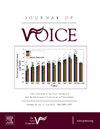Comparison of Outcome Measures (Subjective, Objective, and Patient-Based) in Laryngeal Dystonia Treatment With Botulinum Toxin A Injection
IF 2.4
4区 医学
Q1 AUDIOLOGY & SPEECH-LANGUAGE PATHOLOGY
引用次数: 0
Abstract
Background
Outcome assessment in laryngeal dystonia is hindered by lack of consensus on a core set of outcome measures to quantify treatment effect and disease severity on quality of life. Potential outcome measure domains include objective voice, clinician reported, and patient reported outcome measures (PROMs) for determining treatment success and longitudinal disease tracking. We aim to determine correlations between a selections of outcome measure tools following Botulinum toxin injection.
Methods
A selection of instruments were administered to assess adductor laryngeal dystonia patient outcomes before and after Botulinum toxin injection. Voice samples recorded using a cellular telephone application were used for objective acoustic measures (CPPS, acoustic voice quality index) and speech language pathologist perceptual analysis (CAPE-V). Additionally, patients completed a PROMs battery consisting of the Voice Handicap Index-10, Communicative Participation Item Bank-10, OMNI-Vocal Effort Scale, 3 visual analog scale (VAS) questions. Changes in these outcome measures pre-post treatment were compared between each other and with a global rating of change questionnaire (GRCQ) using Spearman's rank correlation coefficients.
Results
Twenty six patients (20 female, mean age 57.7 years) participated. Using an anchor based GRCQ, patients reported Botox efficacy was the only outcome measure found to have significant correlation (r = 0.54, P = 0.022); all other outcome measures did not meet statistically significant correlation. Amongst the selected outcome tools, several moderate-strong correlations were identified, largely for outcome measures within the same domain. Most notable were correlations between the patient reported OMNI-VES and VAS questions (r > 0.68, P < 0.05), clinician CAPE-V strain and overall severity (r = 0.900, P < 0.001), and acoustic voice quality index with sustained vowel CPPs (r = -0.797, P = 0.002).
Conclusion
Correlation between outcome measures instruments used for patients with adductor laryngeal dystonia requires further attention. Weak correlations with an anchor based GRCQ were found for this study's selected outcome instruments. A select number of correlations were found between outcome instruments within each of the individual outcome measure domains (patient perception, clinical perception, objective acoustics), but there was largely a lack of correlation found for instruments between these three separate domains.
A型肉毒毒素注射治疗喉张力障碍的疗效指标比较(主观、客观和以患者为基础)
背景:喉肌张力障碍的结局评估由于缺乏一套核心结局指标来量化治疗效果和疾病严重程度对生活质量的影响而受阻。潜在的结果测量领域包括客观声音、临床医生报告和患者报告的结果测量(PROMs),用于确定治疗成功和纵向疾病跟踪。我们的目的是确定肉毒杆菌毒素注射后选择的结果测量工具之间的相关性。方法选择仪器对注射肉毒杆菌毒素前后喉内收肌张力障碍患者的预后进行评价。使用移动电话应用程序记录的语音样本用于客观声学测量(CPPS,声学语音质量指数)和语音语言病理学感知分析(CAPE-V)。此外,患者还完成了由发声障碍指数-10、交流参与项目库-10、omni -发声努力量表和3个视觉模拟量表(VAS)组成的PROMs电池组。使用Spearman等级相关系数对治疗前后这些结果测量值的变化进行相互比较,并与全球变化评级问卷(GRCQ)进行比较。结果共26例患者参与,其中女性20例,平均年龄57.7岁。使用基于锚点的GRCQ,患者报告的肉毒杆菌毒素疗效是唯一发现有显著相关性的结局指标(r = 0.54, P = 0.022);所有其他结果测量没有达到统计学上显著的相关性。在选择的结果工具中,确定了几个中等强度的相关性,主要用于同一领域内的结果测量。最值得注意的是患者报告的omi - ves和VAS问题(r > 0.68, P < 0.05)、临床医生的CAPE-V应变和总体严重程度(r = 0.900, P < 0.001)以及持续元音CPPs的声学语音质量指数(r = -0.797, P = 0.002)之间的相关性。结论喉内收肌张力障碍患者预后指标间的相关性值得进一步关注。本研究选择的结果工具与基于锚点的GRCQ存在弱相关性。在每个单独的结果测量领域(患者感知、临床感知、客观声学)中,结果仪器之间发现了一定数量的相关性,但在这三个单独的领域中,仪器之间基本上缺乏相关性。
本文章由计算机程序翻译,如有差异,请以英文原文为准。
求助全文
约1分钟内获得全文
求助全文
来源期刊

Journal of Voice
医学-耳鼻喉科学
CiteScore
4.00
自引率
13.60%
发文量
395
审稿时长
59 days
期刊介绍:
The Journal of Voice is widely regarded as the world''s premiere journal for voice medicine and research. This peer-reviewed publication is listed in Index Medicus and is indexed by the Institute for Scientific Information. The journal contains articles written by experts throughout the world on all topics in voice sciences, voice medicine and surgery, and speech-language pathologists'' management of voice-related problems. The journal includes clinical articles, clinical research, and laboratory research. Members of the Foundation receive the journal as a benefit of membership.
 求助内容:
求助内容: 应助结果提醒方式:
应助结果提醒方式:


